The desire to maintain youth and be attractive at all times was natural for women. There were and are many ways to do this. Today there is a very effective and efficient method for such purposes.
This is a facelift using thread lifting. It is distinguished from all others by its durability and a wide selection of materials for its implementation. Today we will talk about what types of cosmetic threads for facelifts there are, how much they cost, what is best to choose to solve your particular problem, and what reviews clients leave about them.
Why do you need thread lifting?
Modeling the oval of the face using thin fibers is a relatively new type of cosmetic procedure. Something between traditional skin care methods and complex plastic surgeries. Over time, the facial structure begins to lose its elasticity and attractiveness, and unaesthetic sagging and deep wrinkles appear.
Compound
There are three types of lifting fibers. The first type is non-absorbable, they are made from platinum and gold. Partially absorbable and Teflon ones are also used, which dissolve over a very long time.
Previously, lifting bases were made using noble metals that have low chemical activity and are not rejected by the body; these were gold and platinum of the highest standard.
Now they are being replaced with more modern implants. They are made from lactic acid, caprolock and polypropylene and are well accepted by the body.
There are also biodegradable threads, which contain polylactic acid, the effect of which will be noticeable for about 2-3 years, as well as non-degradable ones, created from polypropylene, this composition lasts no more than 4-5 years. Rehabilitation lasts about 10-14 days, but within 30-40 days active facial expressions should be restrained.
Fastening methods
According to the method of fastening, facelift threads are divided into two types. The first type is fixed, they are attached near the temples or in the area of the ears. They differ from stand-alone ones in that they not only eliminate sagging skin, but actively model the oval of the face.
The second type is autonomous, which do not have fixation and cannot provide strong tension to the skin, but simply eliminate sagging and give a certain elasticity.
Texture
- Smooth. This type is used when working with the area of the cheeks, cheekbones, for lifting the chin and modeling the eyebrows. To fix them, it is necessary to make incisions up to 5 millimeters. Suitable for patients aged 45-50 years.
- Notched threads. The main feature of such implants is the presence of special hooks that help to secure themselves in the tissues, clinging like hooks. They are fixed in the subcutaneous layers at a depth of about 4–5 millimeters using micro-punctures.
There are several varieties for lifting different parts (hammock threads for correcting the chin and neck or spring threads, which are designed to shape cheekbones, cheeks and nasolabial folds).
Spiral threads. They allow you to achieve a fairly strong effect of modeling and tightening the oval of the face, this ensures the ability of the frame to take its previous shape after tension.
Spiral threads for face lifting are used both in combination with various types and separately. Their length is usually 40 or 50 mm.
Springs. They have an increased ability to keep the skin in a taut, healthy state. Due to its properties, this type of thread takes root well. Conical. This type was invented about 5 years ago and is popular among specialists. On these fibers there are cone-shaped nodules that act as fasteners, and after a year the cones completely dissolve.Features of the use of absorbable and non-absorbable
Soluble threads will completely disappear after a few months, having fulfilled their function. Today they are produced using polylactic acid and polydiaxanone.
However, you should not expect particularly high results from biodegradable materials, as from insoluble ones. After all, they do not have a rigid fastening and are placed by a cosmetologist close to the surface. Such an implant dissolves within 5-6 months, and new connective tissue begins to form in this place, which subsequently performs a lifting function.
This process activates collagen synthesis and the skin looks more youthful and elastic. The result lasts for a year or two, after which it is recommended to repeat the procedure.
Such threads are installed using local anesthesia; the entire procedure takes about 1 hour. After installation, small bruises and some swelling may remain for approximately 7-9 days.
The polylactic structure of the implant is suitable for patients with thin skin without excess subcutaneous fat; they are also recommended for people with minor age-related changes.
Non-absorbable threads are very thin and have increased strength, usually made of polypropylene. They are fixed in the area of subcutaneous fat, where they form a supporting frame and make it possible to effectively tighten the skin, maintaining the integrity of blood vessels and nerve endings.
The first such threads were smooth, and special return knots were made for fastening. Later they began to produce them from polypropylene with cones and special notches. Non-absorbable implants are carefully inserted under the skin and fixed in certain inconspicuous places.
Everything about ultrasonic facial cleansing: benefits, indications, contraindications and how the procedure works is here.
Photos before and after mechanical facial cleansing can be viewed by clicking here.
How long does the result last, before and after photos
Depending on the type of fibers used, it can last from 2 to 10 years.
The longest lasting effect is provided by a frame made of gold or platinum; it lasts up to 8-10 years.
See how your face transforms after a facelift:
The most popular varieties in cosmetology
APTOS
APTOS Needle - used primarily in surgery, as they are made from non-absorbable fibers and are tightly fixed in tissues using micro-incisions.
Typically, this type of lift is performed in the area of hair growth on the head for people with severe age-related changes, when other cosmetology products have little effect.
Non-absorbable or surgical - these are APTOS threads, which are produced using polypropylene, which are fixed in the subcutaneous fat layers.
The skin receives a good and high-quality frame. Threads can be completely smooth in structure, as well as with various notches and notches.
This type of lifting is effective in areas of pronounced sagging skin - these include nasolabial folds, facial contours, the area of drooping eyelids and double chin. The results from a facelift last for quite a long time – up to 5 years.
Mesothreads
The name 3D mesothreads was given because of a certain property of the invasive “guide” needle, which allows you to create full three-dimensional formation of tissue in all areas and directions. This property of the needle makes it possible, when forming contours, not only to produce high-quality tissue tightening, but also to simulate the contours of “youth.”
Such materials make it possible to create high-level relief.
The high elasticity of the mesothread gives the fabrics a good “springy” result, which increases significantly with the proper installation of several threads on one area of the face.
The created volumetric frame adapts well to tissues and does not cause rejection, allergic reactions or discomfort.
Gold and platinum
Gold and platinum fibers are classified as non-absorbable. They usually take root without problems and are well tolerated by the body due to their low chemical activity.
Such materials were pioneers in thread lifting. But even now such implants are very popular.
Silhouette Lift Soft
The method of forming an oval using this type of retainer makes it possible not only to very quickly, but also quite successfully and without risk to health to eliminate unwanted age-related changes. This technique can only be compared with a full facelift using plastic surgery.
This tightening technique is one of the most modern trends in cosmetology.
It allows you to eliminate signs of age-related tissue changes efficiently and in a short time, while side effects are practically eliminated.
The recovery and rehabilitation period is also significantly reduced.
This method was first tested among cosmetologists in the United States and Spain and has now become widespread throughout the world. The use of Silhouette Lift involves fixing non-absorbable threads made from particularly strong compounds that are highly biocompatible; they do not cause an allergic reaction and are well tolerated by the body.
Average prices
The cost of a thread lifting procedure depends on various factors: the type and shape of the threads and their quality, the material from which they are made, the country and level of the manufacturer. Also, the cost of a face lift with threads includes the services of a cosmetologist, rent of premises and other expenses of the medical center. Their number and location on the body are also of great importance.
- The average price of a procedure using Aptos Needle for tightening the soft tissues of the face and chin is 50,000-60,000 rubles.
Materials from the Aptos Vizage series will cost more and this is approximately 70,000-80,000 rubles.
The price category for lifting using mesothreads in various clinics ranges from 15,000 to 30,000 rubles. The cost of gold threads in various beauty salons ranges from 30,000 to 70,000; a platinum frame will cost 80,000-120,000 rubles. A lift using Silhouette Lift and Silhouette Lift Soft materials will cost approximately 40,000-60,000 rubles.You can find out how a facial cryomassage session works and what the prices are for this method of rejuvenation and cold treatment here.
And why they are needed, what are the indications and contraindications, and what are the features of cryosauna procedures, read here.
Customer Reviews
Valentina, 50 years old, accountant:
“As I got older, my face began to lose shape, and strong sagging appeared on my cheekbones and chin. I decided to have a lift using gold threads. The procedure was long and painful, but the effect was wonderful. The double chin has disappeared, the oval of the face has straightened out and become much younger. The cost of the entire session cost 50,000 rubles.”
Angela Ivanovna, 45 years old, sales manager:
“A year ago I had a cheek and cheekbone lift using mesothreads; a friend recommended a good specialist. Almost all the wrinkles on the forehead and in the corners of the eyes were gone; there was some slight pain during the session. The only drawback is restrictions during the recovery period. I’m happy with the result, I recommend it to all my friends.”
Natalya, 37 years old, housewife:
“I made the frame using Silhouette Lift, there were sagging and strong folds on the forehead.
The problem was corrected, but after the procedure there was severe swelling and bruising.
The doctor prescribed several healing medications.
They helped remove all the consequences of the operation and now everything is great, the skin has become smooth and elastic.
Of course, this is quite an expensive pleasure, but the effect is good and lasts for a long time.”
Margarita, 53 years old, director:
“The use of mesothreads left a good impression. The procedure itself lasted three hours, I did not feel any pain. But the recovery period was long, there was a feeling of tightness, and slight swelling arose. A month later it all went away and now I’m very happy with my face, it has become much more beautiful and younger!”
Conclusions, video
The choice of materials for this procedure is indeed very wide and it is not so easy to figure it out, but for an initial acquaintance this review will be quite enough. All further and detailed recommendations should only be given by a cosmetologist; he must also competently study your body and select materials that are optimally suited for your problem and will not cause rejection or allergies.
Before deciding on such a rejuvenation method, you need to try other options. If such a procedure cannot be avoided, then you need to undergo a thorough examination and pass all the necessary tests.
Before the procedure, you must exclude all contraindications, and after it, strictly follow the doctor’s recommendations for care during the rehabilitation period. Be healthy and beautiful at any age!
Here's what experts say about tightening threads:
Are face lift threads as harmless and effective as cosmetologists advertise them as?
Face lift threads are one of the most advertised procedures in the field of cosmetology and plastic surgery.
This lifting is positioned not only as safe and gentle, but also as an effective method of tightening the skin in order to give the face the desired contours.
Moreover, the results from the use of threads are comparable to the results after plastic surgery.
To understand whether this is so, it is necessary to carefully study the features of this lifting method and weigh all the pros and cons.
What is a thread lift?
In certain areas of the face, threads made of material biologically compatible with the human body are introduced under the patient’s skin according to a special scheme.
They create a strong frame, thanks to which the necessary relief is recreated, and wrinkles and creases are smoothed out.
This method of rejuvenation, as a rule, is used in cases where more gentle methods (resurfacing, biorevitalization, mesotherapy, etc.) no longer work, and the face is rapidly aging.
But threads are unlikely to help women aged 50 years and older; at this age it is better to think about other methods.
But patients under 35-40 years old can achieve excellent results, which are visible to the naked eye, but do not need to go under the surgeon’s scalpel.
10 advantages of the method
The popularity of this method of correction is explained by the fact that the procedure has many positive characteristics. Among its advantages are:
- long-lasting effect comparable to the result of plastic surgery;
- low degree of trauma - no scars or traces of correction;
- no need to make incisions or excision of the skin: after the procedure, the thinnest needles are carefully removed through barely noticeable punctures, which heal quickly and without leaving a trace, and wearing compression masks is not required;
- no need for general anesthesia - local anesthesia is sufficient, which is provided by special creams and sprays;
- After the tightening, the patient does not need to stay in the hospital and go to dressings;
- compatibility of the materials used with soft tissues;
- natural appearance of the face after a facelift: its native structure is not damaged, all features and contours look natural;
- possibility of correction;
- long-term effect and reasonable cost of the procedure;
- The duration of the procedure is 30 minutes.
Types of threads
Since the facial structure of different people has characteristics, and age-related changes are expressed differently, cosmetologists and plastic surgery specialists use several types of threads.
In each case, their specific type is selected by the doctor. Let's look at the most popular ones.
Smooth (non-absorbable)
Consist of silicone, polyurethane and polyamide fibers. They feature an absolutely smooth surface. They do not dissolve.
These threads are designed for working with deep layers of skin. They are arranged in the form of a loop and are fixed to the bone tissue of the face, therefore they guarantee a serious lift even in cases of severe ptosis.
The method of their introduction is more complex than the others, since in some cases it requires a small incision of the skin.
Mesothreads
They are the thinnest of the absorbable types. The advantage of their introduction is that it is minimally traumatic, since a special blunt-tipped needle (cannula) does not pierce the soft tissues, but pushes them apart.
The downside of these features is that the introduction of mesothreads requires a high level of professionalism, experience and accuracy of each movement from the doctor, since the slightest mistake can lead to tightening of the skin and deterioration of the appearance of the face.
Mesothreads completely dissolve after 6 months from the moment of installation, but during this time they are overgrown with a framework of collagen fibers.
Their supporting effect lasts approximately 2 years (although some experts are skeptical about this period).
This type of thread should be installed in patients aged 30-40 years, since in case of severe sagging they will not work properly.
Aptos threads
They have special notches that help the frame to better secure itself in the tissues. They are located under the skin at a depth of 3-5 mm and are introduced through punctures in the skin.
There are different variations of Aptos products. For example, “hammocks” are designed specifically to eliminate a double chin, and “springs” are designed to combat nasolabial folds and sagging cheeks.
A popular product today is the new line of Excellence Visage threads. They are made from completely biodegradable polylactic acid, which is excreted from the body 12 months after the procedure.
Aptos Excellence Visage threads guarantee significant skin rejuvenation immediately after the procedure. With their help you can correct the following defects:
- drooping upper eyelids and “sad” eyebrows;
- severe ptosis on the cheeks and chin;
- deep wrinkles and creases in the skin on the face and neck;
- nasolabial folds.
The effect of use can last from 3 to 6 years.
Cone-shaped combination threads
They are made from degradable polypropylene and have about 8-11 knots and cones of glycolide and lactic acid copolymer throughout the thread.
The last two materials dissolve and at the same time stimulate the formation of connective tissue, which subsequently guarantees the effect of tissue tightening. Such combined threads are used to correct the oval of the face and tighten skin that has lost its tone.
The disadvantage is that the rehabilitation period is quite unpleasant: the swelling may not go away from the face for a long time, and during the first month the patient is not recommended to smile.
Golden threads
Gold is a hypoallergenic material; in addition, it is time-tested, because gold “threads of beauty” began to be used long before the development of modern options.
Such threads include two components: polyglycol and gold. The latter, in the form of a thin shell, is wound onto a conductor made of synthetic material.
This frame stimulates collagen production and is covered with a sheath of connective tissue. But a significant disadvantage of using gold is the inability to use the services of hardware cosmetology in the future.
In addition, with a sharp change in ambient temperature, the skin noticeably changes color.
When is a lift needed?
Lifting with the help of threads is carried out in the presence of pronounced aging. Indications for use are:
- soft tissue ptosis;
- change in the oval of the face (the face “floated”);
- drooping of the outer edge of the eyebrows;
- deep wrinkles and creases in the skin;
- drooping cheekbones and sagging cheeks;
- nasolabial folds and “folds of sorrow” in the corners of the mouth.
It is recommended to install such a frame for a facelift no earlier than after 30 years, and only in cases of really severe problems. It is better to try to delay this moment and carry out more gentle procedures to rejuvenate and maintain skin tone.
Contraindications
Like any serious manipulation that requires penetration under the skin, thread lifting has contraindications, which include:
CONTRAINDICATIONS
- the patient has viral or infectious diseases;
- pregnancy and breastfeeding;
- blood diseases and low coagulability;
- inflammation of the soft tissues of the face;
- too thick skin;
- oncological diseases;
- diabetes;
- excessive sagging tissue that cannot be corrected in a similar way;
- allergy to painkillers.
How is the lift done?
On average, the installation procedure lasts from 30 minutes to 1 hour. Since the manipulations are painful, the skin must be treated with a cream with an anesthetic and left for a certain time so that sensitivity disappears in the treated areas.
Then the cream is removed, and the places where the needles will be inserted are disinfected. An option for local anesthesia is also treatment with a special spray with ice-caine or injections of appropriate drugs.
The threads are inserted through punctures or barely noticeable cuts in the skin. As soon as the end of the thread has reached the required point, it is pulled in the opposite direction.
This tightens the skin and creates the necessary contour. Notches, hooks and cones, if any, are fixed in the fabrics.
Rehabilitation
The duration of the recovery period depends on the patient’s age, the rate of tissue regeneration, the level of professionalism of the specialist who installed the frame, the quality of the material itself and, of course, on the extent to which the rules of facial care and the doctor’s advice are followed.
Initially, there is swelling and pain in the soft tissues of the face. Immediately after inserting the threads, you should apply cold to your face, and over the next few days try to avoid exposing it to high temperatures and eating hot food.
To relieve pain, the patient is prescribed painkillers. Touching your face with your hands is not recommended. You will have to try to sleep on your back for a while.
In the first month after the tightening, going to the pool, bathhouse, sauna and massage treatments are excluded. It is necessary to limit facial stress.
Side effects
When deciding to install threads, the patient must understand that there are always risks of the following complications and side effects:
- swelling of soft tissues;
- hematomas or whitening of the skin due to decreased blood supply;
- soreness;
- skin damage by a nodule or cone;
- transmission of threads through the surface of the skin;
- uneven insertion of the thread and, as a result, facial asymmetry;
- skin constriction and folding on it;
- allergic reaction to the manufacturing material.
The bed cost of a facelift with threads depends on what material they are made of. In addition, their insertion requires special needles, which also cost a lot.
The price is affected by the treatment area: the larger it is, the more expensive the lifting will cost.
In Moscow, a facelift costs on average from 40,000 to 100,000 rubles. With severe ptosis (grade 2), the price of the service can reach up to 170,000 - 200,000 rubles.
In Kirov, the price order is, of course, somewhat different. For example:
- Multidisciplinary clinic "Hellas" (Lenin St., 80). Insertion of threads will cost from 7,000 rubles. The threads themselves cost from 15,000 to 18,000 rubles.
- Center for hardware cosmetology "Renaissance" (Truda St., 70). Here we offer a facelift with mesothreads at a promotional price - minus 500 rubles per piece
Reviews
Marina, 37 years old:
“I recently applied Aptos Excellence Visage threads to my cheekbones and shaved them. At the clinic, ice was applied after the procedure, so there was only slight swelling on the face, without bruises. Of course, I slept on my back, because I decided not to take any risks until the rehabilitation period had passed.
The effect is really noticeable right away: everything that needs to be tightened up, the oval of the face has improved significantly. Now I plan to rejuvenate my forehead.”
Elena, 38 years old:
“I had the skin around my eyes tightened with mesothreads. The swelling did not go away for a long time, but now the skin is much better than before the procedure. Fine wrinkles have disappeared, crow's feet are almost invisible.”
Alla, 34 years old:
“I decided to put threads in my sagging cheeks after watching a video and before and after photos. It's only been a week and a half, and all I've noticed so far are uneven stripes under the skin and the position of one cheek higher than the other. I'm about to go for correction. You may have to install additional threads.”
Facial rejuvenation with threads is an excellent alternative for those who do not dare to undergo full-fledged plastic surgery, but are not ready to put up with the consequences of gravitational ptosis on the face.
Among the existing varieties of threads, you can choose exactly those that will provide the desired effect, but it should be understood that the result primarily depends on the skill of the doctor who installs them.
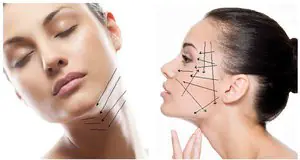
The desire to maintain youth and remain attractive all the time is considered quite natural for women. For this purpose, many effective and efficient methods have now been created.
One of the ways to slow down skin aging is thread lifting. It is distinguished from other methods by its durability and a wide selection of possible materials for the procedure. What threads exist in cosmetology to improve the face, what is their cost, and what is best to choose to solve the problem - all this needs to be understood in more detail.
What is thread lifting for?
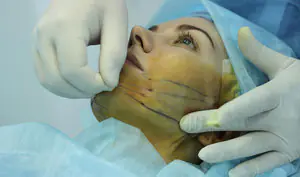
Modeling the overall oval of the face occurs with the help of thin fibers - this is a relatively new type of cosmetic procedures, something between classical methods of facial skin care and complex plastic interventions. Over time, the facial structure begins to lose firmness and elasticity, causing unattractive sagging and rather deep wrinkles.
Thread lifting is needed primarily for those women who want to prolong the youth of their skin and maintain a normal facial structure. This procedure will help avoid major surgery on the face.
What's included
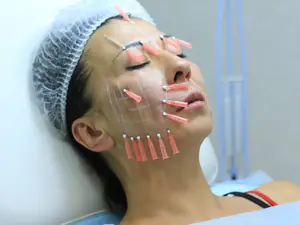
There are three types of fibers for lifting. The first type is non-absorbable threads, they are created from gold and platinum. Partially absorbable Teflon materials are also used, which dissolve over a long period of time.
Previously, the basis for lifting was created using noble metals, which had low chemical activity and were not rejected by the human body, these included platinum and gold of the highest standard.
Currently, they have begun to be replaced with more modern types of implants. They are made from lactic acid, polypropylene, caprolac and are well accepted by the human body.
There are also biodegradable threads, they contain polylactic acid, which affects the face for 2-3 years. There are also non-degradable mixtures made from polymers; such material can last from 4 to 5 years. The rehabilitation process after the procedure lasts 10-14 days, but for 30-40 days you need to continue to maintain passive facial expressions.
Fastening methods

According to the method of fastening threads for face lifting, they can be divided into two types. The first type is fastening, in which they are fixed near the temples or in the area of the ears. The main difference from stand-alone ones is that they not only remove sagging skin, but also actively shape the oval of a person’s face. After this, the result of the tightening is most noticeable.
The second type is free-standing threads that do not require fastening and cannot provide strong tension to the skin, but only eliminate sagging and add more elasticity and firmness.
Features of the structure
Threads for facial rejuvenation procedures can also be divided by texture into:
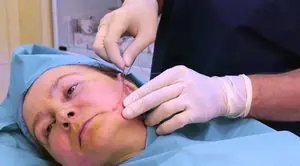
Smooth. This type of surgical threads for face lifting is used mainly when working with the area of the cheeks, cheekbones, for lifting the chin and modeling the shape of the eyebrows. To fix them, the treating specialist makes incisions up to five millimeters in diameter. These threads are well suited for women whose age ranges from 45 to 50 years.- Threads with notches. The main feature of this type of implant is the presence of special hooks that help them to fix into the skin tissue, clinging to it as if with hooks. They are fixed in the subcutaneous layers at a depth of 4 to 5 millimeters using micro-punctures.
- Spiral threads, which allow you to achieve a pronounced effect of modeling and tightening the overall oval of the face, this is due to the ability of the frame to take its initial shape after tension. Spiral threads for face lifting are used both separately and together with different types. Their length most often ranges from 40 to 50 millimeters.
- Springs. They have the property of holding the epidermis in a taut, healthy position. With this effect on the skin, this type of thread takes root in a short time.
- Tapered threads. This material was created five years ago and is still popular among treating specialists. Such fibers have peculiar cone-shaped nodules that function as fasteners; after a year, such cones completely disappear.
Features of using threads
Soluble threads will completely disappear after a few months, having fulfilled their main function. Today they are created using polylactic acid and polydioxanone.
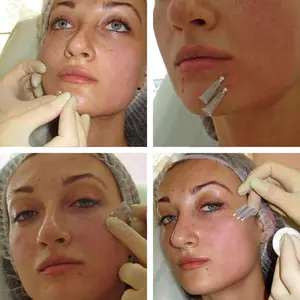
When magnified, polylactic thread looks more like a thin fishing line with small and frequent notches. Thus, it is attached to the tissues and helps to significantly increase their elasticity.
But one should not expect the same effect from biodegradable fabrics as occurs after dissolving ones, because they do not contain rigid fastening, and they are fixed by a cosmetologist very close to the surface of the skin itself. Such an implant completely dissolves after five to six months; connective tissue begins to actively form in this area, which will subsequently perform a lifting function.
This process leads to the active synthesis of collagen components by the skin, as a result of which it looks more youthful and elastic. The result continues to last for several years, after which it is recommended to carry out the procedure again.
Such threads are attached using local anesthesia, the entire procedure lasts on average one hour. After installation, small hematomas and swelling may occur on the skin in approximately 7-9 days. The polylactic structure of the implant may be well suited for a patient who has predominantly thin skin without the presence of subcutaneous fat, and they are also recommended for people with mild age-related changes.
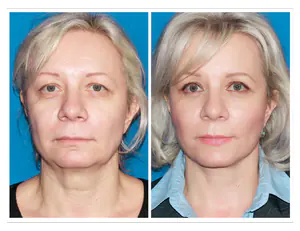
Non-absorbable materials - very thin and contain special strength, most often created from polypropylene. They are attached to the area of subcutaneous fat, where they create a particularly strong frame and make it possible to effectively tighten and strengthen the skin, thereby maintaining the strength of blood vessels and nerve endings.
The first threads produced were of the smooth type, and special return knots were made to secure them. A little later, they began to create polypropylene threads with cones or special notches. Non-absorbable threads are carefully inserted under the surface of the skin and secured in specific places that will not be so noticeable.
This result, depending on the type of fiber used, can last from 2 to 10 years. The duration of action of soluble threads ranges from two to four years, and of insoluble threads - 4-8 years.
The longest lasting effect can be obtained from a frame made of platinum and gold; it continues to stay on the face for eight or ten years.
The most common types
APTOS Needle — used primarily in the surgical field, as it is created from non-absorbable materials and is well attached to tissues using micro-incisions.
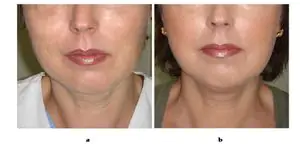
Most often, this type of lift is performed in areas of active hair growth on the head and is suitable for people with severe age-related changes. Non-absorbable or surgical - these are APTOS threads, which are created using polypropylene and attached to the subcutaneous fat layer of the face.
The epidermis receives a strong and high-quality frame. The threads can be completely smooth in texture, or they can have different teeth and individual notches.
This type of lifting is carried out in areas of pronounced sagging skin - these include nasolabial folds, facial contours, areas of drooping eyelids and double chin. After a facelift, the results last for quite a long time - about five years. Absorbable or biodegradable caprolac threads contain lactic acid.
Using mesothreads
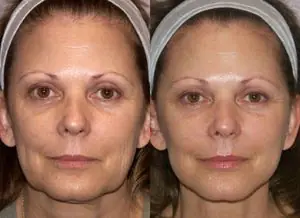
Mesothreads were obtained because of their special property of an invasive needle - “conductor”, which allows the tissue to form three-dimensionally and more evenly in all areas of the face. This property of the needle makes it possible, when developing contours, not only to qualitatively tighten the tissue, but also to model the general contours of young skin.
Such materials make it possible to form a more noticeable relief. The high elasticity of mesothreads gives the fabrics a more springy effect, which increases several times with the correct installation of several fabrics on one area of the face.
The created frame with volume takes root well inside the skin tissue and does not cause any rejection or allergic reaction, and does not cause pain.
Platinum and gold threads
Gold and platinum materials are non-absorbable threads. Most often, they take root in the tissue without being rejected by the body, using low chemical activity.
Such materials have become pioneers in the field of thread lifting. But even now such implants are very popular. Skin tightening with this procedure continues to work for 8 to 10 years.
Silhouette Lift Soft
The method of creating a clear oval face using such a fixative makes it possible not only to quickly, but also quite successfully, without risk to health, to remove all unwanted age-related changes. This technique can only be compared with a full facelift using plastic surgery:
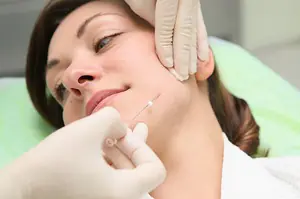
This method of facial skin tightening is considered one of the most modern trends in cosmetology. It helps to quickly and completely eliminate age-related skin changes, while almost eliminating all adverse reactions.- With the help of such threads, the recovery and rehabilitation period is reduced several times.
- This method was first used among cosmetologists in the USA and Spain and has now gained popularity all over the world. The use of Silhouette Lift involves attaching non-absorbable materials made from particularly durable compounds and having a high biocompatibility; they do not provoke an allergic reaction and are fully tolerated by the body.
The choice of materials for such a procedure is really large and varied, it is not so easy to understand the choice, but for an initial acquaintance with threads this information is quite enough. Afterwards, you only need to get recommendations from your attending physician - a cosmetologist; he must fully examine your body and select materials that are optimal for your problem and will not cause rejection or the development of allergies.
Lifting cost
The cost of thread therapy will directly depend on various factors:
- type and general shape of the threads;
- thread quality;
- material;
- country of production and level of manufacturer.
Also, the cost of a facial skin tightening will include the service of a cosmetologist, rent of premises and other expenses of the medical center. The area where they are placed on the face and their volume are of great importance.
The average price for a procedure with threads for the soft tissues of the face in the chin area ranges from 50,000 to 60,000 rubles.
It must be remembered that thread lifting is a serious surgical therapy; it is prescribed only by the attending physician who has the required level of qualifications and experience in this field. Before you decide to undergo a rejuvenation procedure, you need to try other methods. If such a procedure simply cannot be avoided, then you should undergo a thorough examination and pass all the necessary tests.
Before the procedure, you need to exclude all contraindications, and after that, strictly follow all the doctor’s recommendations for care during the rehabilitation period.



